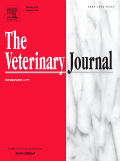Ver ítem
- xmlui.general.dspace_homeCentros e Institutos de InvestigaciónCICVyA. Centro de Investigación en Ciencias Veterinarias y AgronómicasInstituto de BiotecnologíaArtículos científicosxmlui.ArtifactBrowser.ItemViewer.trail
- Inicio
- Centros e Institutos de Investigación
- CICVyA. Centro de Investigación en Ciencias Veterinarias y Agronómicas
- Instituto de Biotecnología
- Artículos científicos
- Ver ítem
Development and diagnostic validation of an ELISA based on an antigenic mixture for the detection of bovine tuberculosis
Resumen
Programs for the eradication of bovine tuberculosis (bTB) focus on the tuberculin skin test (TST) and slaughter of reactor cattle. However, the disease remains an animal health concern in several countries and improving the efficiency of the TST has become a critical issue. The detection of Mycobacterium bovis antibodies in serum, within weeks after the TST, may be a rapid and inexpensive way to improve bTB control. This study reports the validation of an
[ver mas...]
Programs for the eradication of bovine tuberculosis (bTB) focus on the tuberculin skin test (TST) and slaughter of reactor cattle. However, the disease remains an animal health concern in several countries and improving the efficiency of the TST has become a critical issue. The detection of Mycobacterium bovis antibodies in serum, within weeks after the TST, may be a rapid and inexpensive way to improve bTB control. This study reports the validation of an enzyme-linked immunosorbent assay (ELISA) to detect bovine tuberculosis as an ancillary test to TST in dairy farms in Argentina.
The estimated validation parameters were within the established requirements of the World Organization for Animal Health (OIE). The test demonstrated high repeatability, with coefficients of variation <25%. High test reproducibility through interlaboratory testing was also found, with an estimated Pearson coefficient of 0.9648 (95% confidence intervals 0.9315–0.9820). The ELISA detected tuberculous cattle unidentified by the TST. Of 43 animals sent to slaughterhouses that were ELISA positive 15–17 days after a negative TST, 36 were confirmed as infected with M. bovis by histopathology and IS6110 PCR. According to ROC curve analysis of results of 145 cattle from M. bovis-free herds and the 36 M. bovis-infected cattle, at a corrected optical density cut-off point of 0.3853, specificity was 95.95% and the positive predictive value at this cut-off was 83.72%. The ELISA detection test validated in this study could be readily applied in dairy farms, to complement a prior TST and improve livestock health.
[Cerrar]

Autor
Griffa, Natanael;
Moyano, Roberto Damián;
Canal, Ana María;
Traveria, Gabriel Eduardo;
Santangelo, María De La Paz;
Alonso, Maria Natalia;
Romano, Maria Isabel;
Fuente
The Veterinary Journal 256 : 105426 (Febrero 2020)
Fecha
2020-02
Editorial
Elsevier
ISSN
1090-0233
Formato
pdf
Tipo de documento
artículo
Palabras Claves
Derechos de acceso
Restringido
 Excepto donde se diga explicitamente, este item se publica bajo la siguiente descripción: Creative Commons Attribution-NonCommercial-ShareAlike 2.5 Unported (CC BY-NC-SA 2.5)
Excepto donde se diga explicitamente, este item se publica bajo la siguiente descripción: Creative Commons Attribution-NonCommercial-ShareAlike 2.5 Unported (CC BY-NC-SA 2.5)

